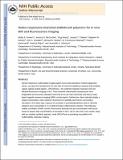Redox-responsive branched-bottlebrush polymers for in vivo MRI and fluorescence imaging
Author(s)
Sowers, Molly A.; McCombs, Jessica R.; Wang, Ying; Paletta, Joseph T.; Morton, Stephen Winford; Boska, Michael D.; Ottaviani, M. Francesca; Rajca, Andrzej; Johnson, Jeremiah A.; Hammond, Paula T; Dreaden, Erik; ... Show more Show less
DownloadHammond_Redox responsive.pdf (858.2Kb)
OPEN_ACCESS_POLICY
Open Access Policy
Creative Commons Attribution-Noncommercial-Share Alike
Terms of use
Metadata
Show full item recordAbstract
Stimuli-responsive multimodality imaging agents have broad potential in medical diagnostics. Herein, we report the development of a new class of branched-bottlebrush polymer dual-modality organic radical contrast agents—ORCAFluors—for combined magnetic resonance and near-infrared fluorescence imaging in vivo. These nitroxide radical-based nanostructures have longitudinal and transverse relaxation times that are on par with commonly used heavy-metal-based magnetic resonance imaging (MRI) contrast agents. Furthermore, these materials display a unique compensatory redox response: fluorescence is partially quenched by surrounding nitroxides in the native state; exposure to ascorbate or ascorbate/glutathione leads to nitroxide reduction and a concomitant 2- to 3.5-fold increase in fluorescence emission. This behaviour enables correlation of MRI contrast, fluorescence intensity and spin concentration with tissues known to possess high concentrations of ascorbate in mice. Our in vitro and in vivo results, along with our modular synthetic approach, make ORCAFluors a promising new platform for multimodality molecular imaging.
Date issued
2014-11Department
Massachusetts Institute of Technology. Institute for Soldier Nanotechnologies; Massachusetts Institute of Technology. Department of Chemical Engineering; Massachusetts Institute of Technology. Department of Chemistry; Koch Institute for Integrative Cancer Research at MITJournal
Nature Communications
Publisher
Nature Publishing Group
Citation
Sowers, Molly A., Jessica R. McCombs, Ying Wang, Joseph T. Paletta, Stephen W. Morton, Erik C. Dreaden, Michael D. Boska, et al. “Redox-Responsive Branched-Bottlebrush Polymers for in Vivo MRI and Fluorescence Imaging.” Nature Communications 5 (November 18, 2014): 5460.
Version: Author's final manuscript
ISSN
2041-1723